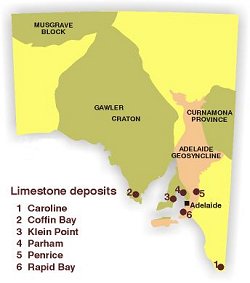
Limestone is a sedimentary rock composed of calcium carbonate (CaCO3). Most is formed by the accumulation and subsequent solidification of marine fossil debris, but freshwater limestone deposits are also known. Marble formed by the metamorphism of limestone is an important source of calcium carbonate in South Australia, as is shellgrit, an unconsolidated accumulation of sea shell debris found in beach ridge deposits along the coastline. Metamorphism of the limestone will recrystallize it as marble but generally this does not effect its capacity as an industrial material.
Uses
Limestone is one of the most useful and versatile of all industrial minerals. One of its oldest uses is the manufacture of lime (calcium oxide, CaO). Mixtures of lime and sand have been used as mortar since the ancient Greek and Roman civilisations. When limestone is heated in a kiln to approximately 1000ºC, carbon dioxide is driven off to form quicklime which, is mixed with water to create the less aggressive slaked lime (or builders lime Ca(OH)2). Slaked lime when wet and exposed to the atmosphere will absorb carbon dioxide to reform calcium carbonate which has a cementing action.
- CaCO3 [limestone]+ heat --> CaO [quicklime] + CO2 [carbon dioxide]
- CaO [quicklime] + H2O [water] --> Ca(OH)2 [slaked lime]
- Ca(OH)2 [slaked lime] + CO2 [atmospheric carbon dioxide] --> CaCO3 [calcium carbonate] + H2O [water]
This has been largely superseded with the development in the 19th century of Portland cement which uses some limestone in its manufacture. Portland cement has revolutionised the construction industry, and has become one of the largest industrial uses of limestone. The world now consumes approximately 1.5 billion tonnes of cement each year. Portland cement is made by mixing limestone with shale or argillaceous material, which contain silica, alumina, and iron-bearing minerals. Firing to temperatures of approximately 1480ºC produces fused material consisting of complex silicates and aluminates in the form of hard glassy balls known as cement clinker. This is cooled and sent to storage for export or grinding into cement; 3–5% gypsum is generally added to the clinker at the grinding stage as a retardant to prevent premature setting of concrete.
Limestone is used in the production of soda ash (sodium carbonate, Na2CO3), the most important alkali compound in use in the chemical industry, with applications in paper, soap and detergent manufacture, tanning, water treatment, and industrial waste treatment. Sodium carbonate is an important component in glassmaking, constituting approximately 20% of the weight of a glass batch, and is used as a feedstock for the manufacture of a range of sodium chemicals including sodium hydroxide (caustic soda). Natural soda ash is not mined in Australia, and all production comes from a Solvay plant operated by Penrice Soda Products at Osborne (a northwestern suburb of Adelaide). The process uses as feedstock calcium carbonate from the Penrice marble deposit 2 km north of Angaston in the Barossa Valley, and salt from the Dry Creek Saltfields adjacent to Osborne. The series of reactions which commences with production of slaked lime and uses ammonia (NH3) as a catalyst is summarised below:
- CaCO3 [limestone] + 2NaCl [salt] --> CaCl2 [calcium chloride] + Na2CO3 [soda ash]
- In addition to soda ash, the container glass industry uses limestone directly as a flux in the melt and to contribute to the strength of the product.
- Limestone is used as a flux in smelting iron ore, from which it scavenges undesirable elements such as phosphorus, silicon, aluminium and sulphur.
- Finely ground calcium carbonate or ‘whiting’ is used as a filler in many products including caulking compounds, paint, paper, plastics and rubber.
- Quicklime (CaO) manufactured from limestone is used as a basic feedstock for the production of a large range of calcium chemicals including calcium carbide for acetylene production, calcium chlorate (disinfectant), and calcium cyclamate (sweetener).
- Increasing use is being made of limestone in South Australian agriculture to neutralise acid soils induced by the use of superphosphate and high-analysis fertilisers. Sandy soils in high rainfall areas are particularly prone to this problem.
South Australian deposits
Adelaidean
The Brighton Limestone provided limestone for cement manufacture from 1882 to 1952. The first cement was manufactured in Australia in 1882 when William Lewis opened a small kiln at Brighton, a southern suburb of Adelaide, using limestone from the nearby Linwood Quarry. Supplies were supplemented from quarries in the same formation at Reynella which were linked to the plant by flying fox aerial ropeway. Use of this material for cement manufacture ceased in 1952 when the South Australian Portland Cement Co. operations were transferred to Angaston, but the quarries continue to supply carbonate aggregate to the metropolitan construction industry.
Cambrian
Cambrian limestone is widespread in South Australia, in thick formations of the Normanville and Kanmantoo Groups on Fleurieu Peninsula and in the Mount Lofty Ranges, on Yorke Peninsula, and in the Hawker Group of the Flinders Ranges and Stuart Shelf. Many of these Cambrian units have undergone dolomitisation. (See Dolomite commodity review).
Penrice
The most important Cambrian calcium carbonate deposit in South Australia is at Penrice. In 1939, ICI (Aust.) Ltd commenced quarrying operations to supply calcium carbonate to its soda ash plant at Osborne. Operations were shifted to Penrice in 1950. In 1989, the soda ash plant, along with the Penrice quarry and solar evaporation saltfields at Dry Creek, were sold to Penrice Soda Products Pty Ltd. The quarry has recently purchased by Adelaide Brighton Cement Ltd.
The Penrice marble deposit is part of the Early Cambrian Normanville Goup, originally deposited as lensoid limestone reefs which were subsequently metamorphosed, recrystallised and folded. The deposit is 300 m thick, on the near-vertical eastern limb of a southerly plunging, partly overturned anticline. The high-grade central part of the marble formation is generally 95–98% CaCO3, and is flanked by lower grade zones (<95% CaCO3) which are darker in colour due to contaminants and interbedded calc-silicates. Various grades of industrial limestone are produced as well as construction materials.
Almost all calcium carbonate requirements for the Angaston cement works are met from the Penrice Quarry, but Adelaide Brighton Cement Ltd retains reserves in other marble deposits in the same formation elsewhere in the region.
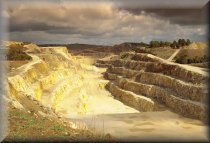
Rapid Bay
A major source of limestone was quarried during 1942–81 by BHP at Rapid Bay, 80 km south of Adelaide, to supply metallurgical flux to the Whyalla, Newcastle and Port Kembla steelworks. The operations, including crushing plant, jetty and loading wharf, were purchased by Adelaide Brighton Cement Ltd in 1981. Limestone typically containing approximately 90.5% CaCO3 was shipped to the Birkenhead cement plant until 1988, when operations were scaled down in favour of increased production from Klein Point. Substantial reserves remain, but ship-loading facilities have been dismantled. The Rapid Bay deposit consists of grey, white and brown medium to coarse-grained banded marble of the Normanville Group, which occurs as a 200–300 m thick lens within a northeasterly trending overturned syncline.
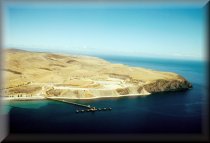
Tertiary
Extensive deposits of limestone occur on Yorke Peninsula, in the Gambier Embayment of the Otway Basin, the Murray Basin, and in the Eucla Basin.
Klein Point
In 1925, the Adelaide Cement Co Ltd commenced quarrying at Klein Point, 6.5 km south of Stansbury on Yorke Peninsula, to supply limestone to its Birkenhead plant. In 1971 this company amalgamated with the South Australian Portland Cement Co. to form Adelaide Brighton Cement Ltd, and the Klein Point deposit continued to be the new company’s most important limestone source. Production averages approximately 1.5 Mt/year of off white to yellow-brown, variably consolidated fossiliferous limestone of the Port Willunga Formation, with total carbonate content in the range 85–92%. The flat-lying fossiliferous limestone unit is approximately 30 m thick. Overburden comprises 3–4 m of calcrete, the lower 2 m of which is high in clay, which also infills solution cavities and pipes extending up to 20 m below the surface. The limestone is extracted by ripping and dozing, although some blasting of hard bands is required. The material is blended, hammer milled to -25 mm and shipped daily to Birkenhead in a purpose-built bulk carrier, the Accolade II.
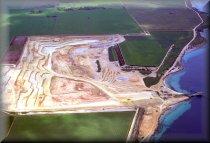
Caroline
Sibelco Ltd has been working the Caroline limestone deposit, 25 km southeast of Mount Gambier, since 1979. The deposit is in the Gambier Limestone, an Oligo-Miocene marine formation consisting almost wholly of bryozoal and shell remains. At Caroline, the limestone is exceptionally white, contains a significant silt-sized and finer carbonate fraction and is low in deleterious non-carbonate materials such as sand, silt, clay, dolomite, flint, iron and manganese. The depth to water table is ~8 m, and overburden comprises approximately 1 m of soil and discoloured limestone.
The deposit is mined by elevating scrapers, and crushed and milled on site before dispatch by road to Australian Glass Manufacturers Co. in Melbourne. About 35 000 t of glass-grade limestone are produced annually and small quantities are also sold for agricultural uses.
Holocene
Parham
At Parham, 65 km north of Adelaide, up to 3 m thick unconsolidated Holocene shellgrit beach deposits of St Kilda Formation have been mined by scraper and screened, dried and crushed on site using a hammer mill and roll crusher. Product is trucked to Adelaide for glass manufacture at Australian Glass Manufacturer’s Croydon plant. About 40 000 t/year of glass-grade material are produced.
Coffin Bay
A large deposit of limesand suitable for blast furnace flux was identified at Coffin Bay in 1959, and a 32 km tramway was constructed to ship-loading facilities at Port Lincoln. BHP commenced production in 1966 and it peaked at 504 000 t in 1969. Growth in coal exports led to replacement of this material by backloading Japanese limestone fines during the early 1970s, and since then production has been limited to relatively small amounts for local use and the Port Pirie smelters. Average grade is 51.2% CaO (91.4% CaCO3). Large reserves of limesand remain in this deposit which consists of mobile dunes up to 60 m high, formed by erosion of the calcareous Bridgewater Formation dune system which accumulated over large areas of southern Eyre Peninsula when broad areas of the continental shelf were exposed in Middle to Late Pleistocene times. The deposit is currently held by OneSteel Manufacturing Pty Ltd.
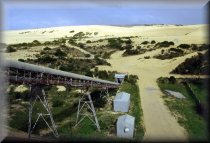
Additional Reading
Flint, D.J., 1998. A review of Gambier Limestone — geology, uses, specifications and production. South Australia. Department of Mines and Energy. Report Book, 88/2.
Johns, R.K., 1963. Limestone, dolomite and magnesite resources of South Australia. South Australia. Geological Survey. Bulletin, 38.
Valentine, J.T., 1989. Industrial and non-metallic minerals — operations in South Australia. South Australia. Department of Mines and Energy. Report Book, 89/74:76-99.


